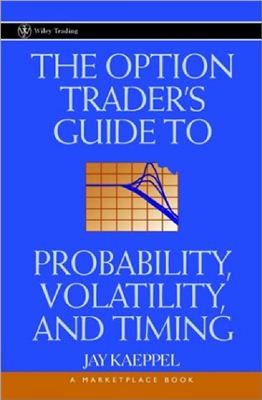Novice traders are attracted to the options market because of
the
degree of leverage and the vision of enhanced profitability it affords
them. Options, however, are unlike any other exchangetraded
product because of leverage, and more importantly,
because of an attribute referred to as time decay. Unfortunately,
traders lea the hard way that many factors besides calling the
market direction correctly come into play in trading options.
Most traders do not understand implied volatility, time decay,
and out-of-the-money versus in-the-money options. Many do not
have a working knowledge of which option strategies are best for
any given situation, and they fail to understand just what the
risk is before they make their trades.
Jay Kaeppel explains these issues in The Option Trader’s
Guide to Probability, Volatility, and Timing. Kaeppel covers the
basics and then goes on to teach how to trade options. And
he doesn’t do it with get-rich-quick examples and hyperbole. He
looks at the options market with a thorough analysis of both
the risk and the profit potential of the various strategies, and he
does so in a very readable fashion.
Kaeppel outlines the steps involved in becoming a successful
trader. He explains the different strategies available and when to
use each one. He shows how to accurately assess volatility and
from there, how to profit by disparities in the implied volatilities
of different options. His strategies include guidelines for determining
when to buy undervalued options and when to sell overvalued
options. Finally, Kaeppel teaches when to take a profit,
and most importantly, when to cut losses and move on to the
next trade.
degree of leverage and the vision of enhanced profitability it affords
them. Options, however, are unlike any other exchangetraded
product because of leverage, and more importantly,
because of an attribute referred to as time decay. Unfortunately,
traders lea the hard way that many factors besides calling the
market direction correctly come into play in trading options.
Most traders do not understand implied volatility, time decay,
and out-of-the-money versus in-the-money options. Many do not
have a working knowledge of which option strategies are best for
any given situation, and they fail to understand just what the
risk is before they make their trades.
Jay Kaeppel explains these issues in The Option Trader’s
Guide to Probability, Volatility, and Timing. Kaeppel covers the
basics and then goes on to teach how to trade options. And
he doesn’t do it with get-rich-quick examples and hyperbole. He
looks at the options market with a thorough analysis of both
the risk and the profit potential of the various strategies, and he
does so in a very readable fashion.
Kaeppel outlines the steps involved in becoming a successful
trader. He explains the different strategies available and when to
use each one. He shows how to accurately assess volatility and
from there, how to profit by disparities in the implied volatilities
of different options. His strategies include guidelines for determining
when to buy undervalued options and when to sell overvalued
options. Finally, Kaeppel teaches when to take a profit,
and most importantly, when to cut losses and move on to the
next trade.

